Electric skateboard history – The evolution of skateboarding
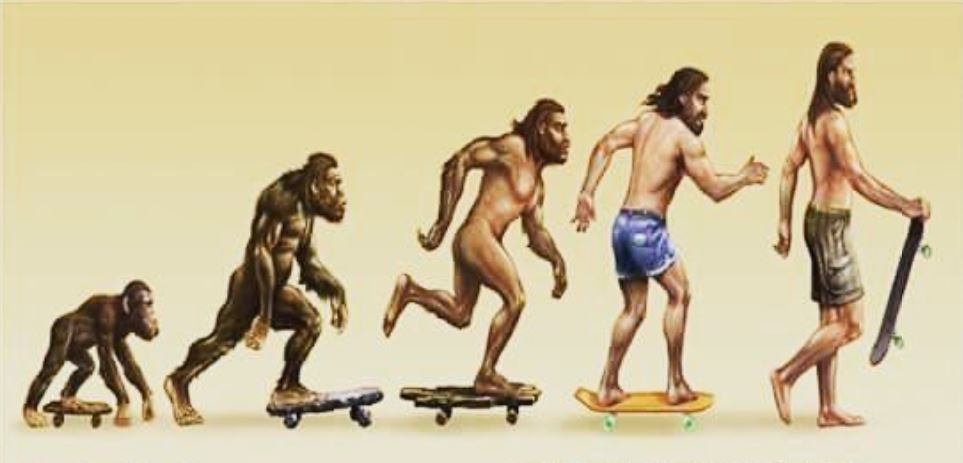
Introduction
I thought I would write a blog about the history of electric skateboarding. This site is dedicated to anything that is electric and one of my favourite things to do in life is skateboarding, so why not write about it aye?
In this article, I’m going to start with the history of traditional skateboarding and how it was founded because, if it wasn’t for traditional skateboarding we wouldn’t have electric skateboards today!
If you were born in the ’80s, you certainly watched Marty Mcfly riding around on skateboards or hoverboards while holding onto cars in “Back to the future”. You felt like it was eye candy for a 5-year-old! I think that any kid wanted to be a skater after watching that film! But there was one drawback… And that was pushing the board. Sure we could ride a skateboard while holding onto a car, but that is very dangerous and could land you with a crushed head! The American dream for any kid in the 80’s was to be a pro skater! Skating has gone from an activity, to a way of life! The punk rock culture behind it was a massive boom in the late 80’s and 90’s, and many kids out there wanted to make a living from it. Now we are able to ride an electric skateboard to work without gasping for air. Amazing! Absolutely rad!
The Traditional Skateboard
Electric Skateboard history started, of course, with the traditional skateboard. I guess you could call it the building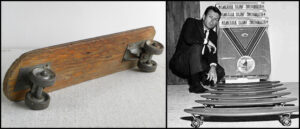 blocks for the industries’ future. There is some history to traditional skateboarding, which I’m going to mention in this article.
blocks for the industries’ future. There is some history to traditional skateboarding, which I’m going to mention in this article.
Skateboarding started in the 1950’s. In the early years, skateboards were handmade out of boxes or planks of wood. The sport was originally called “sidewalk surfing”. The wheels of the board were made out of roller skate wheels and they were attached to a plank of either wood or plastic for a deck. As you can imagine, it was very hard to balance on the board as it was very short and had no grip tape. The original wheels were made out of metal – which was not very good for traction. The traditional skateboard consists of a deck, trucks, wheels, and just nut’s and bolts.
California was the place to be in the post-war era, and skateboards were the footmark of the youth back in the day. Metal wheels were replaced with clay but this compound was too fragile and broke very easily. The manufacturing of skateboards started in 1959. Frank Nasworthy who is pictured in the top right photograph invented polyurethane wheels in the early 70’s and this alone revolutionised the skateboard as the wheels rode smoother than the clay wheel design of the day. Nasworthy started a company called Cadillac Wheels and from that point onwards polyurethane wheels were a huge success.
 Surfers started riding skateboards as if it was a surfboard especially when polyurethane wheels came out. The problem with surfing was you only can get the best waves in the morning or in the afternoon when the waves were at it’s biggest. A skateboard was used during the day to practice the surfing style. I highly recommend watching a documentary called “The Lords of Dogtown”, which chronicles the events that lead to modern-day skateboarding. In the mid-1970s in Santa Monica, there was a place called Dog Town, and surfers Tony Alva, Stacy Peralta, and Jay Adams enjoyed surfing in the morning and afternoon but also wanted to skate like surfers during the day. Skateboard designer Skip Engbloom was given polyurethane wheels in his surf shop called Zephyr Surf Shop. The locals decided to test these wheels and were amazed by its grip. Skip then decided to pick a famous surf team to became a skate team. Tony Alva, Stacy Peralta, and Jay Adams were the Z-boys. They are pictured in the top left. At the time, the drought in California was bad, and a lot of swimming pools in people’s yards couldn’t be filled up due to this. So the Z-boys started skating in empty pools. Vert skating was born from this point onwards and became the genesis of swimming pool skateboarding. These boys made Skateboarding mainstream, and competitions started around this time.
Surfers started riding skateboards as if it was a surfboard especially when polyurethane wheels came out. The problem with surfing was you only can get the best waves in the morning or in the afternoon when the waves were at it’s biggest. A skateboard was used during the day to practice the surfing style. I highly recommend watching a documentary called “The Lords of Dogtown”, which chronicles the events that lead to modern-day skateboarding. In the mid-1970s in Santa Monica, there was a place called Dog Town, and surfers Tony Alva, Stacy Peralta, and Jay Adams enjoyed surfing in the morning and afternoon but also wanted to skate like surfers during the day. Skateboard designer Skip Engbloom was given polyurethane wheels in his surf shop called Zephyr Surf Shop. The locals decided to test these wheels and were amazed by its grip. Skip then decided to pick a famous surf team to became a skate team. Tony Alva, Stacy Peralta, and Jay Adams were the Z-boys. They are pictured in the top left. At the time, the drought in California was bad, and a lot of swimming pools in people’s yards couldn’t be filled up due to this. So the Z-boys started skating in empty pools. Vert skating was born from this point onwards and became the genesis of swimming pool skateboarding. These boys made Skateboarding mainstream, and competitions started around this time.
Vert skateboards were very different from the early plastic fishtail boards. The wheels were 55mm or larger and had wider bamboo wood decks for stability. The grip tape was also introduced for more grip on the skateboards.
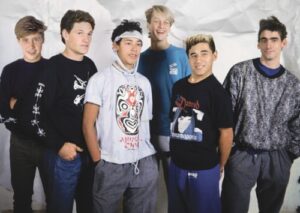
The 1980s had seen a massive rise in skateboarding culture. There was a company called Powell Peralta, founded by George Powell and Stacy Peralta, ex-member of Z-boys. Powell Peralta sponsored a skating team called The Bones Brigade and this alone changed skateboarding culture! The team was made up of such people like Tony Hawk, Rodney Mullen, Steve Caballero, Mike McGill, Lance Mountain, and Tommy Guerrero. They are pictured on the left. New Tricks were invented, like the famous olie – or 360. The sport became extremely creative in terms of skating – I don’t think there will be another period like it! They took skating to a whole new level and kids from all over the world idealised these skaters.
The 1980’s skateboards had changed dramatically since the fishtail skateboards of the ’70s. The boards were bigger and had bigger wheels. The skateboard deck ranged from 8.75 wide and up, and it had no nose. The board had a very small to little concave. The wheels were a thicker shape and were 60mm and up. There was also different wheel compounds, depending on what style you skated. These boards were a lot smoother and could go a lot faster than its predecessors. The truck system was more advanced and the boards had risers underneath the trucks so the wheels would not rub against the deck itself. Grip tape became the normal. Vert skating changed from swimming pools to ramps and the early skate parks were developed for this type of skating. Tony Hawk was one of the first pioneers in vert skating. From then on, skateboarding hardware was developed further and further: shapes changed, and boards became wider, more concave and featured a nose and tail.
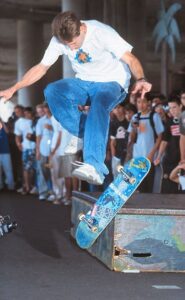
Rodney Mullen who was a part of the bones brigade decided to create a style called street skating. He would come up with many different tricks, like for example the ollie & kickflip. Rodney Mullen was the grandfather of modern freestyle street skating. His picture is on the right. Vert skating became something from the past, as more and more skaters decided to do street skating. The culture of street skating changed as it brought skaters back to the streets, and a new generation & culture of skaters were born. In the 1990s, skateboarding became dominated by street skateboarding and vert skating became a thing of the past. Increased board size and improved truck constructions helped the new style thrive. It was during this time that a distinctive youth subculture began to develop around the sport. Punk rock and baggy clothes became closely associated with young skaters. The daring and individualistic nature of street and vert skateboarding was spread through straight-to-video documentary films that found a large youth audience. The size of the boards is about 7 1⁄4 to 8 inches. The size of the wheels for street skating range from 50 to 60mm, and the skateboard decks range from 7 to 10.5 inches wide and 17 to 84 cm long. The skateboard wheels are made out of hard polyurethane, as opposed to the softer polyurethanes used on old skateboards. This is to stop the wheels from bouncing if you do tricks on the board. The modern traditional skateboard is derived from the freestyle boards of the 1980s, but the shape of the board is narrow in width and has 2 x kick tails.
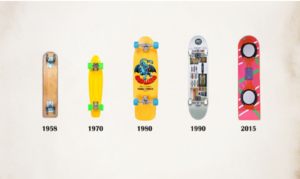
Traditional skateboards over the years.
The First motorised skateboard
The first motorised skateboard was very heavy and had a two stroke combustion petrol engine, which is typical of today’s string trimmers. It was 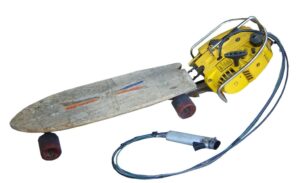 developed in the mid-1970s by a company called Motoboard. The person who invented the board was a man named Jim Rugroden, from a town called Campbell in San Francisco, while on a break from his physics studies in the summer of 1975.
developed in the mid-1970s by a company called Motoboard. The person who invented the board was a man named Jim Rugroden, from a town called Campbell in San Francisco, while on a break from his physics studies in the summer of 1975.
The prototype Motoboard evolved from a simple push start to a precision automatic shaft-driven sports vehicle with a 2 stroke chainsaw motor. It used to turn heads as it rode past as it was very loud. The board was made out of wood and the deck was small. This board was the grandfather to modern-day motorised skateboards. Rugroden then met entrepreneur Bill Posey at a photoshoot for Skateboarder magazine in Calsbad, San Diego California, and they both formed a partnership – Quantimotion, Inc. DBA MotoBoard International.
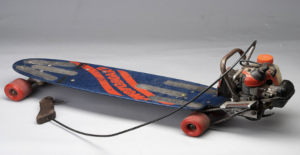
Motoboard Combustion Engine
The manufacturing started in a small shop in Sunnyvale, California. Rugroden manufactured the units and Posey established a southern California base in Calsbad where a lot of the marketing, promotions and sales were done. A brand new facility was established in 1979, after the company was successful at the Foreign Trade Zone San Jose, California. This board became very popular amongst the youth of the time. The marketing of the board was made through magazines such as Playboy, High Times, Road & Track magazine & Time.
The price at the time for the motorised board was $650 – which is a lot more than what an average skateboarder could afford. It had a fringe market of people who loved to ride these boards. Unfortunately, these boards were banned in 1977 in the state of California, due to high pollution and noise. But in the heyday they would have no doubt turned some heads!
Posey and Rugroden parted ways in 1983, but the company still exists today going by the name Los Banos California under the assured name MotoBoard Intl.
The first electric skateboard
What better way to discuss the next topic for electric skateboard history than to discuss the origins of the first electric skateboard? The invention of the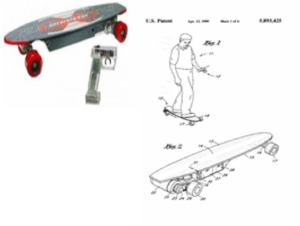 first electric skateboard was kind of an accident… It’s amazing how a series of events can lead to one of the best inventions known to man!
first electric skateboard was kind of an accident… It’s amazing how a series of events can lead to one of the best inventions known to man!
It was invented in 1997 by a man called Louie Finkle. He went into a hobby shop to buy an electric motor and left the shop with a wireless remote as well. He had a friend who built longboards, and so the 2 ideas combined. He mentioned the idea was a “cool foundation” of sorts, where an idea for wireless, battery-powered, motorised skateboards would come from.
Although Finkle had no background knowledge for electronics, he stated he was “born to understand the machine”. He said that he would walk around the neighbourhood scouting for parts from things that people would throw away. Finkle would then take things apart and find ways to incorporate it to his ideas. He loved machines that moved, and he had a natural instinct to how these machines operated. And so he created the prototype in 1997, and it was US patented in 1999.
The board went from 0 to 22 miles an hour in 4 seconds, and the price was $995. It had a unique feature in the manner in how the machine operated. It turned the user into a conductor of energy. The metal strip touched the finger on the remote, and this in hand transferred a low signal through the feet and half an inch through the deck of the board receiver.
They made advancements through the 2000’s with battery power, capacity and size. The boards were originally designed with lead acid batteries. The product was a massive hit – but there was still a problem… The product itself was still too expensive. Only from 2006 onwards would batteries have sufficient torgue to power the boards efficiently, making it cheaper to maintain.
Louie’s invention became a business called eXkate., It had produced more than 1500 boards and had a massive customer base. With the development of modern day electric skateboards, these boards became obsolete. The skateboard itself was very noisy as it was a single belt driven board. It doesn’t have the power compared to the electric skateboards that are available today. The modern electric skateboards have a choice of dual belt, dual direct drive or dual hub motors. All modern day boards are lithium based and the remotes are Bluetooth.
Louie eventually sold his company, citing the quality and reputation of the company was destroyed… He compared selling his company to “watching a gazelle being eaten by a lion”.
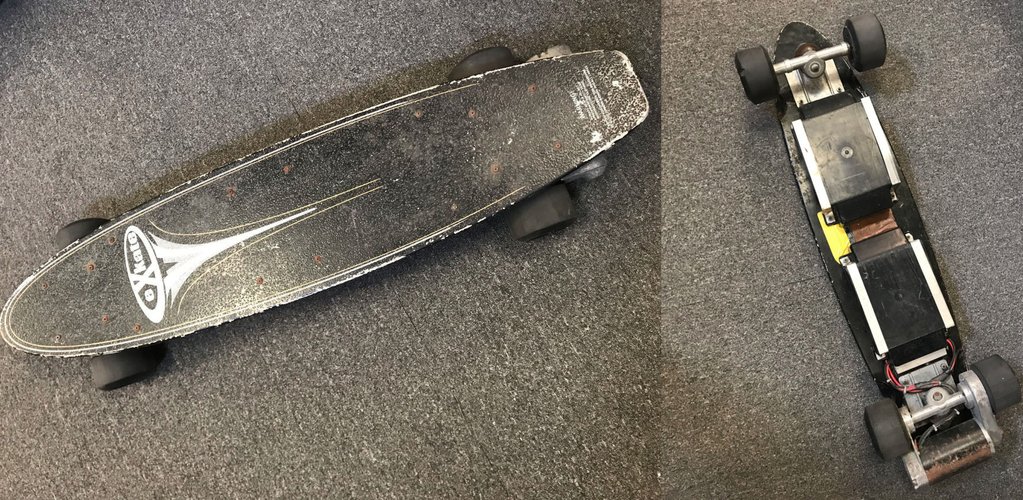
Exkate
The future of electric skateboards
Electric skateboards have since become very popular!
Electric skateboards prices range from $200 to $1500, and it seems to have become a competitive industry with all of the manufacturing parts being built mainly in China.
The popularisation of electric skateboards has become a massive industry in itself. This is due to individuals like Casey Neistat, Jay Boston, and Ronnie Sarmiento. All 3 of these You tubers have influenced the general public and the e-boarding community to massive heights. Now you have lot’s of competitors out there producing high quality boards, and it looks like the e-skating community is continuously increasing! Cowabunga Dude!

Conclusion
These days you have many players in the industry – and it is only going to get bigger! The bigger the industry is, the more options you have for a fun alternative transportation. I just love riding these things! And I am sure there are many people out there that feel the same way! I have listed above all the manufactures for electric skateboards. It is a huge market!
From the very beginnings of traditional skateboards to the smell of the gasoline motorised boards, we know this industry is fast evolving. We now have quiet electric skateboards – and maybe the next step up wll be flying hoverboards! I do hope so!
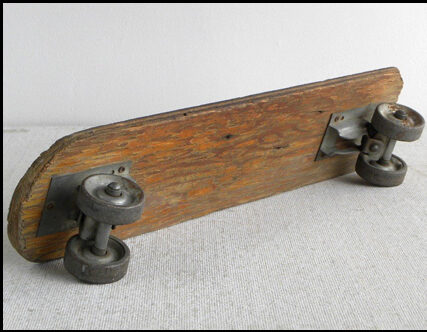
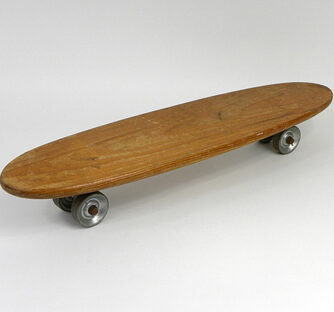
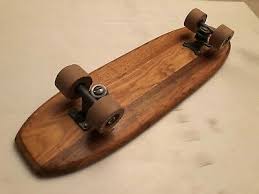
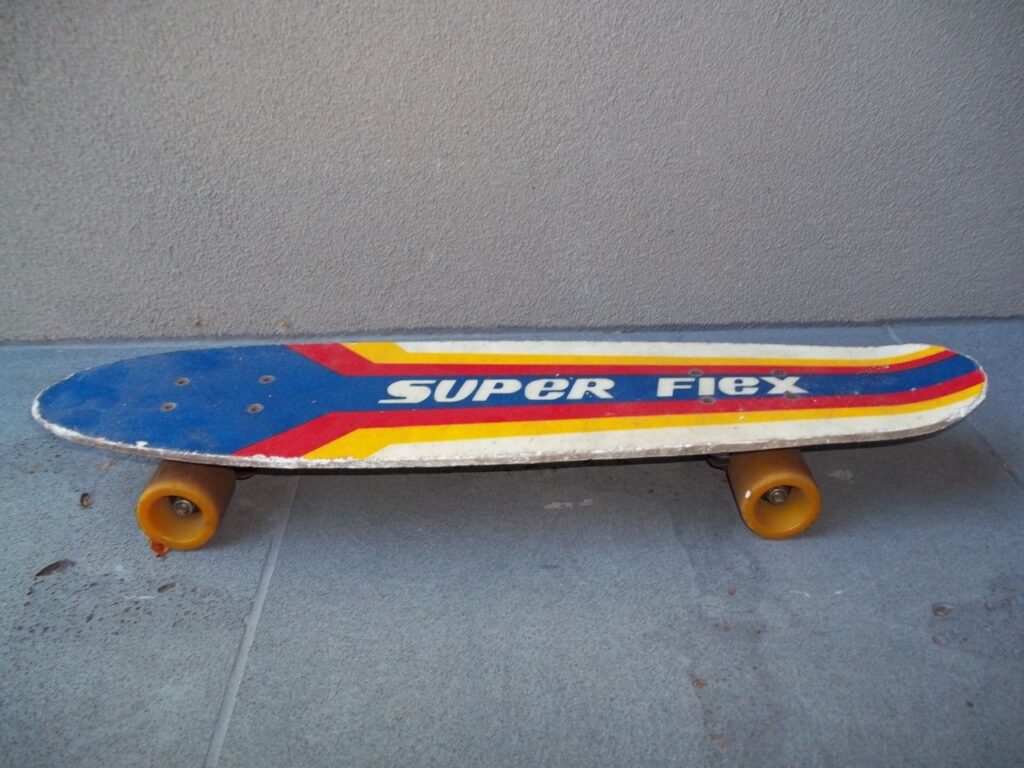
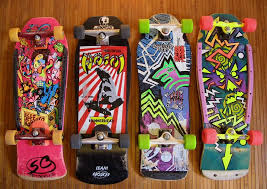
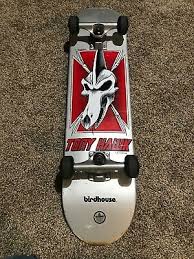
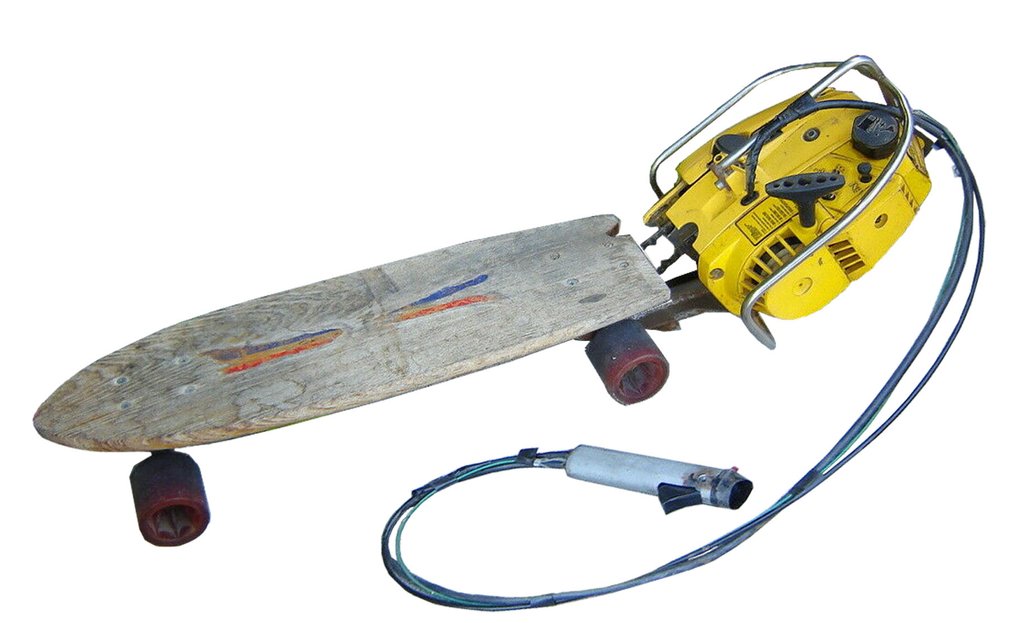
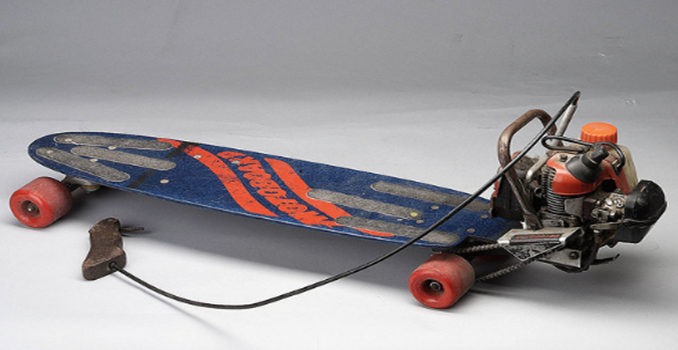
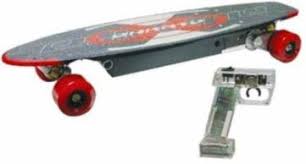

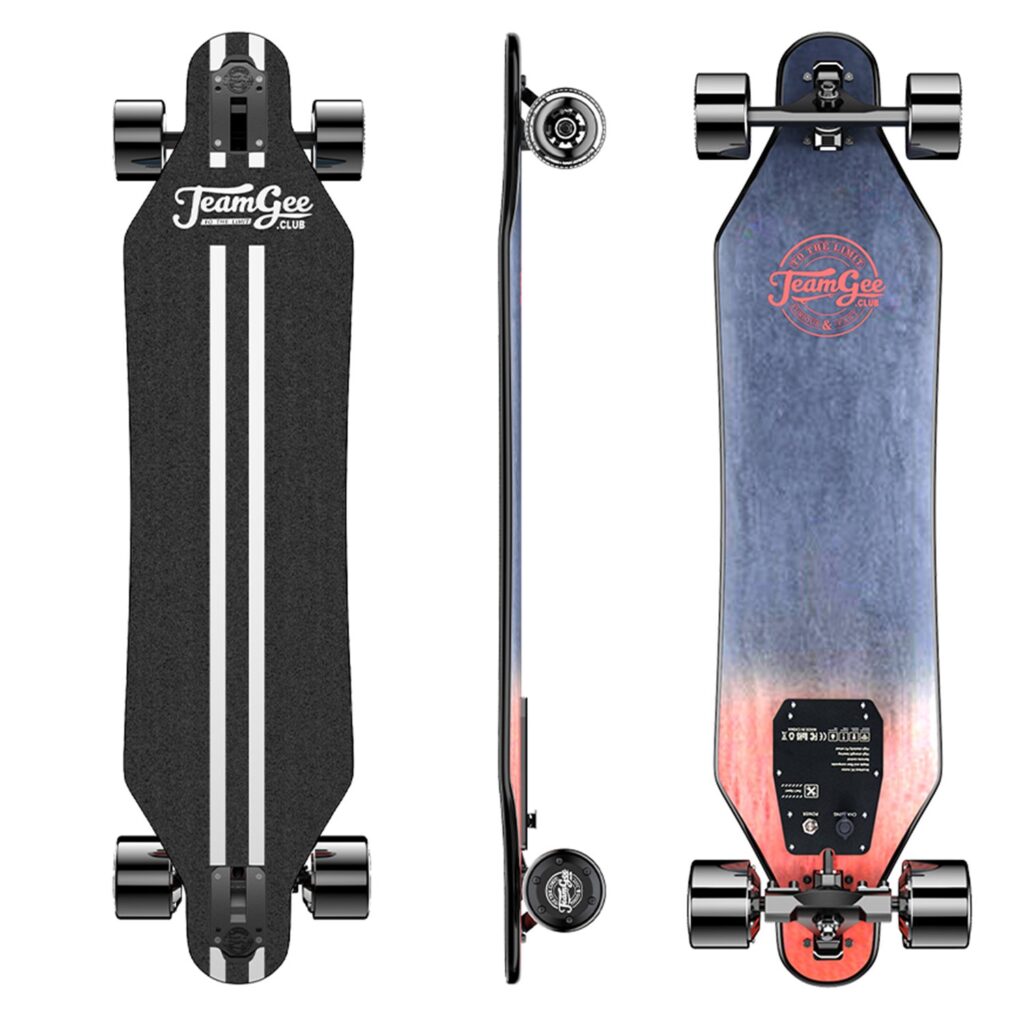


2 Responses
This is a fantastic article! A lot of history in relation to skateboarding.
Thank you for your comments Tom we appreciate it.
Comments are closed.